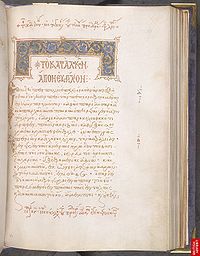Minuscule 480
|
New Testament manuscript |
|

The beginning of the Gospel of Luke (f. 101)
|
|
| Text | New Testament (except Revelation) |
|---|---|
| Date | 1366 |
| Script | Greek |
| Now at | British Library |
| Size | 32.8 cm by 23.1 cm |
| Type | Byzantine text-type |
| Category | V |
| Note | marginalia |
Minuscule 480 (in the Gregory-Aland numbering), δ 462 (in the Soden numbering), is a Greek minuscule manuscript of the New Testament, on parchment. It is dated by a colophon to the year 1366. The manuscript is lacunose. The manuscript was adapted for liturgical use. It has marginalia. It contains liturgical books with hagiographies: Synaxarion and Menologion.
Scrivener labelled it by number 568.
The codex contains the text of the New Testament except Book of Revelation on 268 parchment leaves (size 32.8 cm by 23.1 cm), with only one lacuna (Hebrews 12:17-13:25). The text is written in one column per page, 23 lines per page. The vellum is fine and white.
The leaves 225-226 were supplied by a later hand on paper (flyleaves). It has decorated headpieces and initial letters at the beginning of each Gospel (folios 3, 63, 101, 163). The titles, initials, and capital letters in gold (chrysography).
The text is divided according to the κεφαλαια (chapters), whose numbers are given at the margin. It does not contain the τιτλοι (titles of chapters). The text of the Gospels has no additional division according to the smaller Ammonian Sections, with references to the Eusebian Canons.
It contains tables of the κεφαλαια (tables of contents) before each book, lectionary markings at the margin (for liturgical use), αναγνωσεις (lessons) are marked at the beginning and end, Synaxarion (table of lessons beginning at Easter) on folios 213-217v, Menologion (table of lessons beginning at 1 September) on folios 218-222v, subscriptions at the end of each book, numbers of στιχοι, and scholia. Lacuna in Hebrews 12:17-13:25 was supplied by a later hand on paper.
...
Wikipedia
